San Diego Super Chargers!
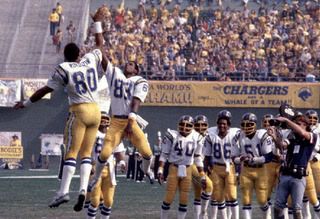
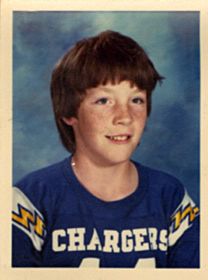 Yup, that's me. Dike-Newell School, Bath, Maine. Fifth grade. American badass.
Yup, that's me. Dike-Newell School, Bath, Maine. Fifth grade. American badass. I could tell you I was wearing that dopey grin because I was proud that I convinced my mom to let me wear my Sears-bought Dan Fouts No. 14 Chargers jersey for picture day. But the truth is, well, that's how I always looked in fifth grade: like a sports-obsessed, girl-repelling doofus with too few branches on his family tree. Of course, pictures can be deceiving - this is right about the time the Coastal Maine Crips and the Bloods both were heavily recruiting me. True story.
Anyway, about the shirt. This probably isn't the best time to get nostalgic about all this, given that the Chargers are intent on ending our dynastic Patriots' season Sunday, but I'll offer the confession nonetheless: I loved the Chargers as a kid. Worshipped them, from John Jefferson to Charlie Joiner, from Gary "Big Hands" Johnson to Louie Kelcher, from Rolf Benirschke (who later became the worst game-show host of all-time) to Dan Fouts. Yes, I admit it: I dug them more than I did the Patriots.
Hey, cut me some slack - kids are fickle like that. They're attracted to shiny objects, and the Chargers couldn't help but catch your eye. They lit up the scoreboard with the flashiest offense of their and perhaps any other era, the famed "Air Coryell" attack, named for their innovative head coach, Don Coryell. They always seemed to be playing on NBC at 4 p.m. Sunday, with Dick Enberg (he was ancient even then) and Merlin Olsen calling the game. (The Patriots, meanwhile, suffered through a two atrocious seasons in three years during this period and were often blacked out on local TV.) The field at Jack Murphy Stadium was sun-drenched, such a stark, intriguing contrast to grey, frigid winter lurking outside my window. And though they never made a Super Bowl - their defense always failed to hold up its end of the bargain, much like Indy's nowadays - they were involved in two of the most memorable playoff games in league history. Oh, and the lightening bolts on the helmets? Those clinched the deal. Too cool.
Eventually, time, geography, peer pressure, and the fancy footwork of one Tony Collins properly realigned my allegiances toward Foxboro. That came as much relief to my dad, an exasperated Pats fan who somehow resisted stuffing me in a box and mailing me to the San Diego Chicken whenever I'd argue that Kellen Winslow was a much better tight end than Russ Francis, or that Stanley Morgan had nothing on J.J. With the benefit of wisdom and hindsight, I long ago conceded my old man's arguments to be true . . . well, at least in Morgan's case.
But now and again, I still think about those golden afternoons watching the Chargers - when Kellen Winslow Jr. makes "SportsCenter" for catching a touchdown or popping a wheelie, or when I catch Fouts calling a college football game, when I see that famous J.J. Jefferson Sports Illustrated cover, or when I run across some ridiculous 25-year-old picture of myself. And wouldn't you know it, all these years later, that same dopey grin creases my face again.
So then, here are a couple of anecdotes and characters from my youthful Chargers fixation, as well as a wish from the long-since converted: Once the Patriots get done shattering their Super Bowl dreams Sunday, San Diego fans will have no choice but to still remember the Air Coryell years as the best they ever had. And that's really not so bad.
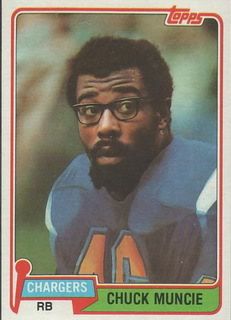 CHUCK MUNCIE
CHUCK MUNCIEPowerful yet remarkably fluid, Muncie was one of the most talented all-around running backs of his time - and undoubtedly the most talented among those who wore thick black-rimmed glasses on game day. In 1981, he ran for 1,144 yards and 19 touchdowns while averaging a stellar 4.6 yards per carry, and also caught 43 passes out of the backfield. Yet three years later, at age 31 and in good health, he was gone from the league for good. The reason: cocaine, which history has revealed to be a particularly common weakness of those Chargers. Muncie's affinity for the drug was made public in a Sports Illustrated cover story in which teammate Don Reese exposed the shocking depths of the NFL's drug problem in a first-person account. That considered, I suppose it's probably not good form to find the following quote from Tales From The Saints' Sideline downright hilarious:
Muncie remembers freebasing cocaine during training camp with Reese when the straight-laced [Archie] Manning popped in. They bluffed their way out of the spot, Muncie recalls, by telling Manning they were cooking soul food.
Oh, those naive Mannings. Somehow, I could see Peyton doing exactly the same thing. Chip off the ol' rube, that kid.

JOHN JEFFERSON
If you're an NFL fan of an age close to mine, you surely need no introduction to John "J.J." Jefferson. From 1978 to '80, he was very possibly the finest receiver in the NFL, and he was undoubtedly the flashiest. Nicknamed the "Space-Age Receiver" for the goggles that gave him a distinctively futuristic look, he made more acrobatic, did-you-just-see-that? catches than any receiver I have ever seen, Lynn Swann included. He was great, and you're damned right that's the appropriate word. Jefferson became the first receiver in league history to surpass 1,000 receiving yards in each of his first three seasons, and he looked like he was on his way to becoming a genuine legend. But after a contract dispute in '81 - Chargers owner Alex Spanos was notoriously cheap - he was dealt to Green Bay, and after a couple quality seasons playing opposite James Lofton, his ability abandoned him so swiftly that he found himself out of the league in 1985 at age 29. With no telltale scars on his body and no ominous rumors about his off-the-field habits, his decline was such a mystery that SI ran a small story titled "What happened to J.J. Jefferson?" after the Cleveland Browns let him go. SI didn't reveal a conclusion, other than insinuating that maybe he didn't work hard enough in his heyday. Jefferson has done very well for himself after his playing career ended - he held a prominent position in the University of Kansas athletic department, and at last check, he was the director of player development for the Washington Redskins - but those who remember him from his glorious seasons in San Diego can't help but wonder why the sunset came so soon.

GARY "BIG HANDS" JOHNSON
I know, I know, his name sounds like he should be sharing billing with Jenna Jameson. But trust me, "Big Hands' had other claims to fame besides his mammoth mitts. Check out the man's resume: He led the NFL in sacks (17.5) in 1980. He was a first-team All-Pro in '80 and '81. He made the Pro Bowl from 1981-'83. He collected 67 sacks in 10 seasons (1975-84) in San Diego. After he struggled to adjust to playing nose tackle in the Chargers' new 3-4 defense in '84, he was dealt to the Niners and sacked Dan Marino during San Francisco's Super Bowl XIX victory. And, most notably (or maybe not), he was yours truly's favorite Charger of them all. Why? The whims of an 11-year-old, mostly. I remember getting the pictured football card - a coveted AFC All-Pro! - and instantly deciding that he'd be one of my favorites. I thought it was cool that he appeared to have no front teeth. And the clincher came when I read a story in my dad's "Inside Sports" (or maybe it was "Sport") about how he pulled himself out of a game because teammate Wilbur Young had a hellacious case of gas and he couldn't take the stink. "I might be 'Big Hands,' " Johnson said, gasping for fresh air, "but right now I wish I was "Small Nostrils.' "
Labels: Chuck Muncie, Gary "Big Hands" Johnson, John Jefferson

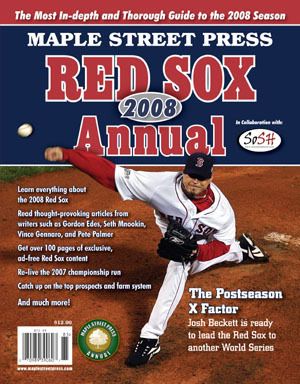
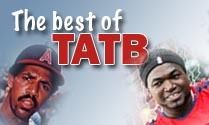









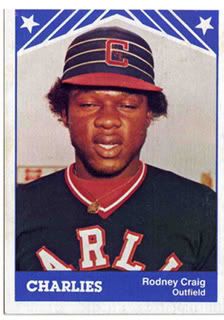
|
<< Home